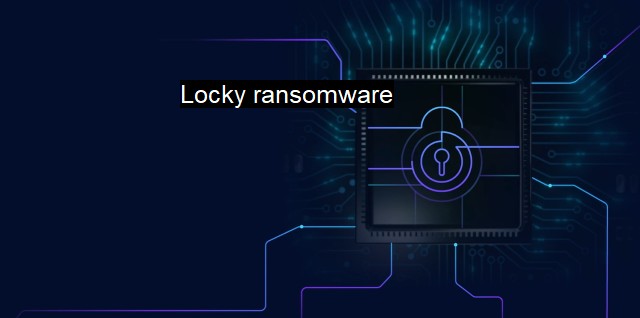What is Locky ransomware?
Preventing Cybersecurity's Most Malicious Threat: An In-Depth Exploration of Locky Ransomware and Effective Antivirus Strategies to Combat Its Damages
Locky Ransomware is a kind of malware that infiltrates a user's machine with the primary objective of encrypting the victim's files and making them inaccessible. It typically disguises itself as a legitimate email attachment or uses infected software applications. The ransomware is notorious in the cybersecurity landscape for its relentless attacks on corporations, governments, and individuals worldwide.Baptized "Locky" because of its standard modus operandi of renaming user's files with the ".locky" extension, this cyber threat renders files completely unusable. Therefore, this cyberattack creates a complete breach, freezing an individual or a corporation's daily activities, causing loss of time and financial resources.
Locky ransomware is an updated model that exhibits relentless evolution tactics. The hackers behind it are always experimenting, constantly improving on its delivery methods and intensifying the extent of their encryption algorithms to cause maximum damage and trigger bigger pay-outs. it started using RSA-2048 and AES-1024 encryption algorithms to encrypt files after the initial blow-out.
The infection method adopted by Locky is primarily through spam emails containing a disguised malicious attachment. Once the user opens the attachment, a macro is triggered to deliver and execute the ransomware on the victim’s system. These spam emails often appear immunogenic to the individual, often as invoices, bills, or reminders.
Upon successful infiltration, Locky ransomware starts scanning for files to encrypt on local drives, network drives, and other shared resources, indiscriminately targeting all the popular file formats. Post encryption, it changes the file name into ".locky" or other derivative extensions and leaves ransom notes in each folder containing the encrypted files.
Despite many claims that the ransom can sometimes restore access to the encrypted files, addressing this ransomware’s extortion demands is strongly discouraged by cybersecurity experts. There are several reasons for that. First, it only encourages and financially supports these cybercriminals for further illicit activities. Secondly, there is always the risk of cyber offenders not sticking to their part of the agreement after getting the payment, leaving the victim without access to their files.
So, how can one stand against such a formidable adversary?
It starts with cybersecurity education; individuals and corporations need to be trained on identifying phishing emails and the negative implications of opening attachments from unknown sources. Regularly updated antivirus software is crucial, shedding light on suspicious activities and providing real-time protection against threats.Also, frequent backing up of important files cannot be over-emphasized. In the event of a Locky ransomware attack, loss of access to important files can be mitigated if a recent backup has been made offline or on a cloud platform shielded from the ransomware. The backups should be tested regularly to ensure they work efficiently anytime they are required.
Keeping all software updated prevents infections from exploiting vulnerabilities that outdated, or "end of life" software may have. Also, a regularly updated operating system helps in bouncing off such infections.
Cyber threats like Locky ransomware are sophisticated and continually evolving, making absolute protection challenging. Still, the steps above do provide discernable layers of defense. Cybersecurity is about mitigating risks to a reasonable and manageable level, and you should never feel helpless when exposed to the likes of Locky Ransomware.

Locky ransomware FAQs
What is Locky ransomware?
Locky ransomware is a type of malicious software that encrypts the victim's files, making them inaccessible, and demands a ransom payment in exchange for decrypting them. It usually spreads through email phishing campaigns and exploit kits.How does Locky ransomware infect a computer?
Locky ransomware can infect a computer through various means, including email attachments, malicious links, exploit kits, and infected software bundles. It usually uses social engineering tactics to trick users into opening or downloading its payload, which then installs the ransomware on the victim's computer.What should I do if my computer is infected with Locky ransomware?
If your computer is infected with Locky ransomware, you should disconnect it immediately from the internet to prevent further damage. You should also contact a cybersecurity expert or an IT professional to help you remove the ransomware and restore your files, if possible. Paying the ransom is not recommended, as it does not guarantee that your files will be decrypted, and it only encourages the attackers to continue their criminal activities.How can I protect my computer from Locky ransomware?
To protect your computer from Locky ransomware, you should keep your operating system and software up-to-date with the latest security patches, use a reliable antivirus program, avoid opening suspicious emails or attachments, and backup your important files regularly to an external device or cloud storage. You should also educate yourself and your employees about the dangers of phishing and social engineering attacks, and practice safe browsing habits when using the internet.| | A | | | B | | | C | | | D | | | E | | | F | | | G | | | H | | | I | | | J | | | K | | | L | | | M | |
| | N | | | O | | | P | | | Q | | | R | | | S | | | T | | | U | | | V | | | W | | | X | | | Y | | | Z | |
| | 1 | | | 2 | | | 3 | | | 4 | | | 7 | | | 8 | | |||||||